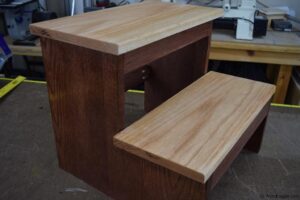
If you make one of these be sure to post a picture of it over on the WoodLogger Facebook Page. I’d love to see how yours turns out.
Material List
- (1) 1″ x 4′ x 4′ Oak Plywood
- (1) 1″ 8″ x 4′ Oak
Cut List
- (2) Sides – 3/4 x 15-3/4″ (front to back length) x 14″ (top to bottom length)
- (4) Stretchers – 3/4 x 2 x 14″
- (1) Top Step – 3/4 x 9-1/4 x 17″
- (1) Bottom Step – 3/4 x 7-1/2 x 17″
Milling & Assembly
Items Used to Finish this
